|
|
|
Hagia Sofia vs. the Blue Mosque
Sunday, October 9 2005
setting: Megido Street, Tel Aviv, Isræl
Today we'd be flying back to Istanbul, this time for a four day Turkish experience. We drove our rental car to Ben Gurion Airport fully expecting rather intense scrutiny from a security apparatus that deals with lots of terrorists but has a good record of keeping them off of airplanes. Before even getting to the airport, we passed through a security checkpoint on the highway. Then, once we'd dropped off our car, there was another checkpoint just inside the building. Most people were getting their bags xrayed here, but said the right things and used a little Hebrew with the guy who came around asking questions, so we bypassed that procedure and were permitted to go straight to the ticket counter. We found ourselves surrounded by a low wall of enormous Texas-sized posteriors. Even before they opened their mouths, I could tell their owners were Americans. They were part of a tour group that had come to see the Holy Land with an outfit called Calvary Tours. My sense was that not a single one of them had ever read a book by Kurt Vonnegut.
I find myself having even less patience for Christianity now that I knew their religion is really just Baal woship dressed up to look like monotheism. Actually, my impatience isn't really so much with Christianity, which actually seems more appealing now that I know it's really Baal worship covered in vinyl siding. My impatience is with Christians who sanctimoniously think they're following in a tradition started by the Jews, whom they acknowledge as God's chosen people. Then, when evangelizing their faith, they act as though it follows some sort of logic. "For God so loved the world, that he gave his only begotten Son, that whosoever believeth in him should not perish, but have everlasting life." - John 3:16 and "God sent His Son, Jesus Christ to come to this earth and die on the cross to pay the penalty for your sin." - JesusGift.com. But this stuff makes no sense at all! Jesus died nearly 2000 years before I was born, but I don't get how his death could be seen as absolving even his contemporaries of their sins. If I get a tooth pulled at the dentist, am I supposed to infer that this has an effect on someone else's cavities either now or into the endless future? Not if I have any sense!
As we stood waiting for the enormous luggage of these enormous Americans to find its way onto a conveyor belt, off in the middle distance of the airport we heard the call of a shofar. A shofar is a ram's horn used for certain Jewish religious rituals and evidently airport security personnel were making someone prove his shofar was indeed a shofar, thereby throwing a little comic relief into what is otherwise a dreary and somewhat tense ordeal.
From that point on, there didn't seem to be anything remarkable about airport security. We'd been through so many checkpoints in a country full of checkpoints, and once we'd been through one more conventional airport security checkpoint, authorities could be pretty certain we weren't going to be blowing up or hijacking an airplane. There's a big food court area in the center of Ben Gurion where WiFi internet access is provided for free (all you have to do is agree to the terms set forth on a splash screen).
Several hours later we'd landed in Istanbul. We'd been fretting about whether or not we'd need a Visa and it turned out that we did. But the process of obtaining one for each of us took about ten seconds and we didn't even have to wait in line. The Visa is really just a tax, which for Americans is $20 each. As for passport control and customs, it was about as effortless as it had been in France, that is, the whole process seemed perfunctory.
We half expected our hotel to have sent someone to pick us up, but no one was waiting with sign with either of our names, so it looked like we'd need to catch a taxi. Very quickly we determined that our cash card wouldn't work in any of the airport cash machines but luckily we had over a hundred dollars in American currency that we could convert into Turkish lyra, each of which was worth about seventy cents. Evidently there's a history of severe inflation in the country, because there are two kinds of lyra in existence. There is the old kind, simply called "Turkish lyra" and then there is the new kind, which is worth precisely a million times the old kind. When I write of the lyra in relation to dollars, I'm writing about the new kind, abbreviated "ytl" and jokingly referred to by Gretchen and me as "yetils." There are still old lyras in circulation, but they're always high denomination bills having at least six zeroes.
As we approached the old city from the west along the coast of the Sea of Marmara, spectacular stone ruins became increasingly frequent. In one case the highway ran right through a gap in an ancient stone wall some 15 feet in height.
Our hotel was the Sokullupasa Best Western near the Blue Mosque. There was nothing special about it, though I quickly found a weak (though usable) open WiFi signal coming from some nearby building. This would be the first time on this trip when we could get free internet access in a hotel room.
After dropping our stuff off in our room and getting something called a "pizza" at a nearby restaurant, we immediately set off to explore nearby Istanbul. Heading northward up to the top of the slope, we quickly came to the Sultanahmet Mosque, also known as the Blue Mosque, completed in the 1616 and famous for having six minarets (more than any other mosque in Turkey). Its cluster of minarets would make it very easy for us to find our way home as we walked around Istanbul.
The Blue Mosque isn't just a major tourist attraction, it's also a functioning mosque. To handle the volume of tourists while still providing an area where the devout can do their thing, there are separate entrances and, inside the mosque itself, a discreet fence. As we the tourists entered the mosque, we were expected to remove our shoes. Bags were provided to hold our shoes, which could in turn be placed in little cubbies inside the mosque. People were encouraged to wear something other than shorts, miniskirts, or outfits that revealed shoulders (even of the kind last lusted over in the 1950s). Women were also expected to cover their heads with blue scarves being handed out at the door, but a good fraction of the women tourists (including Gretchen) left their heads uncovered without any consequences (from either Heaven or Earth).
The presence of hundreds of socked feet that had, moments ago, been sealed up in shoes, gave the interior of the mosque the distinct fragrance of smelly feet. The floors of the mosque were thickly carpeted and it seemed these carpets would be a willing reservoir for the fragrance, storing it for occasions when no smelly tourist feet are present.
Inside, the Blue Mosque's most striking features, aside from its enormous interior space, are the four enormous fluted columns used to support the dome. Once my attention moved on from that there were other things to catch the eye, such as hundreds of stained glass windows, acres of marble-covered wall, and then vast stretches of ceiling featuring swirls of calligraphic painted decoration. Other parts of the ceiling had been left completely blank.
While we were there, an Immam was leading a service in Turkish for the male congregants, the only people allowed beyond the interior barricade. Women, on the other hand, had exclusive access to the balconies. Gretchen went up there with my camera and took pictures of things no male tourist ever gets to see.
Next on the agenda was the famed Hagia Sophia (or, as the Turks say, Ayasofya), built as a church for the Byzantine Emperor Justinian in the mid 500s, more than a thousand years before its neighbor, the Blue Mosque. While the Blue Mosque is an elegant bubbly grey structure whose six minarets give it a Darth Vadery exuberance, Hagia Sophia is comparatively blocky in appearance, with mismatched minarets that were added after the Ottoman conquest (1453). Unlike the Blue Mosque, Hagia Sophia wasn't overengineered at the outset, and its clunky exterior is the result of many corrections needed throughout the years as it was shaken by earthquakes and various terrible things happened, such as the repeated collapsing of its dome.
Also unlike the Blue Mosque, Hagia Sophia is now a museum and it costs money to enter it. Once inside, you immediately see what the hoo-haw is about. Inside, Hagia Sophia is a mind-blowing spectacle, making the interior of the Blue Mosque look like the wood-paneled Court of the Town of Esopus by comparison. The interior ceilings are thickly-encrusted with Christian mosaics, many of them with backgrounds of gold. Here and there these mosaics are covered with plaster painted with calligraphy, a legacy of Hagia Sophia's time as a mosque. One of the things that makes Hagia Sophia unique is that you can stand in some places and take a picture containing both Christian figurative mosaics and Islamic calligraphy, or, some cases, a combination where one bleeds through into the other.
In places where the wall isn't covered with mosaics, interesting things have been done with the marble. A sheet of marble will lie right beside its near mirror-image, the next cross-section in a thick block of quarry stone. Whole walls are covered with such mirrored stones.
The floor of Hagia Sophia is bare stone, much of it cracked and worn into smooth gulleys by the passage of years and millions of footsteps. Evidently, though, the present floor is at a different level from the floor of yore. In one place is a pair of ancient doors that must forever stay open; their lowest fractions lie at the bottom of two-foot-deep trenchs.
Hagia Sophia is an enormous building and its restoration and maintenance require that it be a perpetual construction site. Currently a massive scaffold rises from the floor to just beneath the dome, part of an ongoing effort to clean the mosaics at the top. While they're there, the regularity of the scaffold's horizontal struts help give a sense of the vertical scale.
Both the Blue Mosque and Hagia Sophia lie on the east side of an ancient horse raceway, the Hippodrome. The raceway is long gone and now the Hippodrome is a long, narrow open space that, in this season, is thickly-lined with shops selling food both to tourists and to breakers of the daily Ramadan fasts. Three ancient pillars are the only relics of the Byzantine days when horses raced here. At the south end is a masonry and stone obelisk dating to 10th Century. Then there's the bronze ruin of a Greek sacrifical tripod, now a broken serpentine column. Finally, and most spectacularly, is a 3000 year old obelisk brought from Egypt and erected in the year 390. Incredibly, it was ancient when it was erected, but at this point it has spent more time in its present location than it did where it was constructed. Being made of granite, it has survived the æons without any evident erosion, though the 1700 year old carvings in the marble block on which it stands have lost many of their details. All of these monuments stand in six foot deep wells, the level of the Hippodrome in ancient times.
In its day, the Hippodrome was the place where the Byzantine emperors displayed the loot stolen during various conquests, campaigns, and occupations. It's fitting, then, that many of the Hippodrome's most spectacular features were looted and have ended up in other places. For example, a pair bronze horses from the Hippodrome eventually ended up adorning the façade of St. Mark's Basilica in Venice. Smaller bronze features were mostly melted down and converted into coins by the members of the Fourth Crusade, then running amok and in no danger of reaching the Holy Land.
Near the Hippodrome is the entrance to an ancient Byzantine cistern, named the Yerebatan Sarnıçı. After paying a fee, we were allowed to descend the staircase and walk around inside on a raised catwalk. The cistern is a massive subterranean room that now holds about two feet of standing water in which large fish can be seen swimming languidly. The most interesting thing about this cistern is the grid of columns holding up its ceiling. When the cistern was being constructed in the year 550 or so, the Roman Empire was already ancient and there were apparently plenty of columns that could salvaged from the ruins of old earthquake-ruined temples. So a variety were used in this cistern, where appearances were not of critical importance. Near the middle of the grid on the left is a column covered with a pattern of teardrops, the sort I'd never learned about back when I took Latin. Creepier and far more affecting are the stones supporting two smallish columns in the back left corner. They are marble cubes delicately carved with the faces of Medusas, one lying on her side and the other upside down. There's something incredibly moving about these silent, still Medusas that shines straight through the thick crowds gathered on the walkway around them. But I can't really say what that something is exactly. You'll have to actually go there and see for yourself to know. In the meantime, I'll explain it as a melancholy that comes from the recycling of precious sculpture for mundane purposes. These medusas had surely had a far more noble perch at some point in their existence, but for the past 1700 years they've been turned at unflattering angles and made to hold up Constantinople, usually from beneath several feet of water. Gretchen was so moved by these Medusas that tears came to her eyes and we had to go back and, having walked away, we had to go back and look at them a second time. Nobody else in the crowd seemed to be especially moved; the tourists were all jockeying for position trying to get a Pulitzer-Prize-winning photo. Meanwhile, at a level almost beneath consciousness, a soundtrack of ethereal classical music echoed perfectly between the columns from a hidden sound system.
Next we walked down to the Galata Bridge and went down to its lower level, where various restaurants sell fish sandwiches, which Gretchen had read about in the guide book and thought I should take advantage of. A young man on the sidewalk was clapping his hands together and telling people to come in and have a sandwich. We ignored him as we had already become accustomed to doing in this the land of the aggressive merchant, but then we doubled back and sat down. I ordered a fish sandwich and a beer (I just said "beer," something I'm going to try doing in America) and Gretchen simply ordered a tea. As we dined, we joked with the young man doing the sidewalk marketing. Such joking was not easy, because the only English he knew was "Hello! Come in, sit down!" It amounted to us pointing out new potential customers for him to accost. I found the bread in my sandwich stale, but otherwise it was okay.
The Galata Bridge crosses a body of water called The Golden Horn. On its north side is a steep hill featuring a 150 foot tall stone tower called Galata Tower. At the bottom of the tower we tried to just get in the elevator without first buying tickets, but the employees there are apparently smart about such things in a way that they just aren't in the United States and we were evicted without serious consequences (i.e., a night in a Turkish prison). It's a good thing we did finally take the elevator with tickets in hand, because at the top someone was checking to see whether or not we had them. There's a restaurant and nightclub taking up the top several floors of the tower, but nobody seems to be too interested in hanging out in either of them. Instead everyone goes out onto a narrow balcony that runs all the way around the tower. From there you can look out over Istanbul in all its sparkely minaret-studded glory. By now the sun had set and several mosques were displaying huge messages in Turkish on webs of Christmas lights that had been woven between their minarets.
In the Galata neighborhood there's a pedestrian mall rather like the one in Charlottesville, Virginia or Santa Monica California. Galata's is called İstiklal Caddesi and it runs for many blocks. Like Ben Yehuda Street in Jerusalem, İstiklal Caddesi must serve as the occasional target of Turkish terrorist groups (Kurds, Al Qaeda, etc.) because there were plenty of police on hand, many carrying big machine guns. After surveying the options, we dined at a place featuring a couple of women in the front window wearing traditional Anatolian costumes and baking flatbread. The restaurant itself was divided down the middle with an artificial stream flowing through a wilderness of plastic plants. Cheesy though all these things were, most of the customers appeared to be Turkish, although we were successful when we ordered in English.
Heading back towards the six minarets of the Blue Mosque, we ran down deserted streets past pathetic kittens looking through garbage. Istanbul looked to have even more cats than Jerusalem.
Though it was late, the Hippodrome was one big nonstop party, crowded with people both eating and selling food. During Ramadan, food becomes a special pleasure, and people will gladly stay up all night drinking tea and eating food. In Turkey they'll also drink plenty of wine; the Ottomans never tried very hard to stomp out that paricular legacy of the Roman Empire.
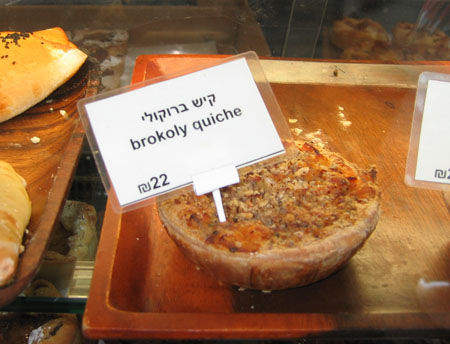
An interesting spelling for "broccoli" in Ben Gurion airport.
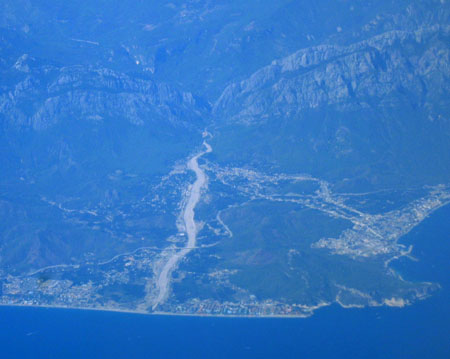
City on the southern Anatolian coast.
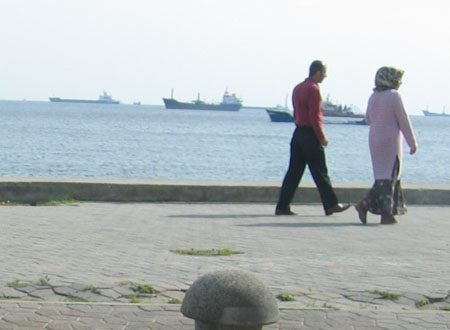
Couple strolling along the Sea of Marmara near Istanbul's Old City.
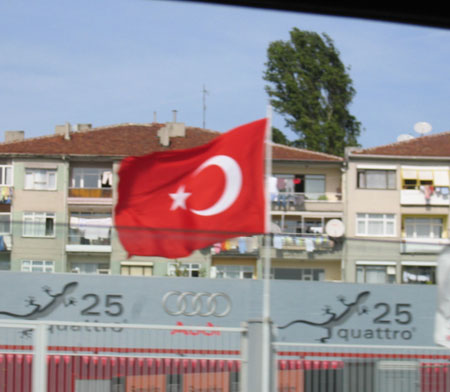
Newish apartment buildings on the way from the airport.
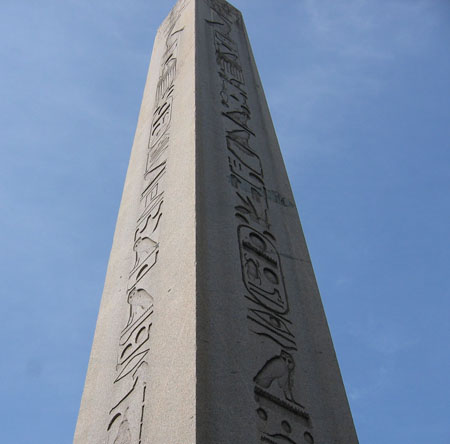
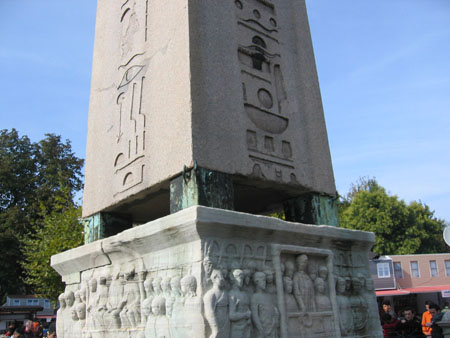
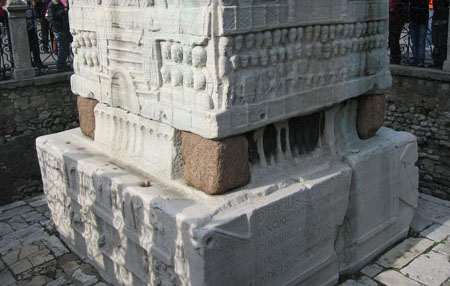
The 3000 year old granite Egyptian obelisk on the Hippodrome, with its 1700 year old marble base and the strange bronze cubes that connect the two.
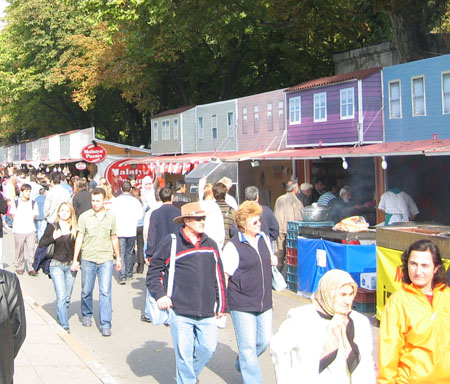
Makeshift shops lining the Hippodrome. Note the goofy faux second story windows.
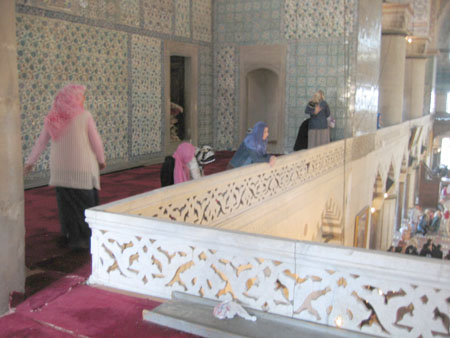
The women's balcony in the Blue Mosque.
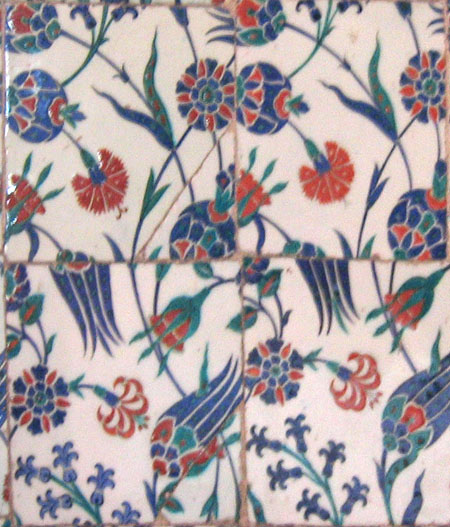
Tiles in the Blue Mosque.
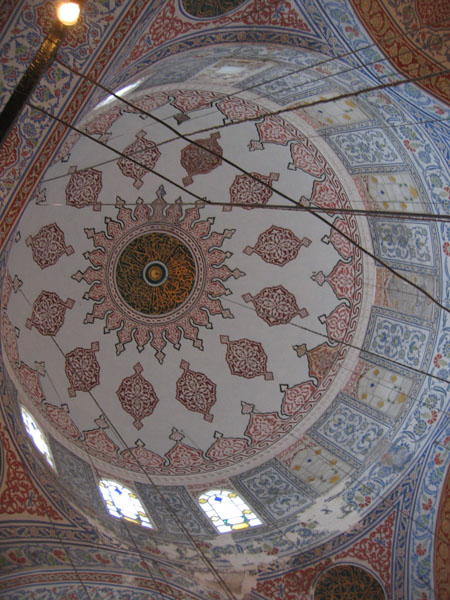
Underneath the Blue Mosque's dome.
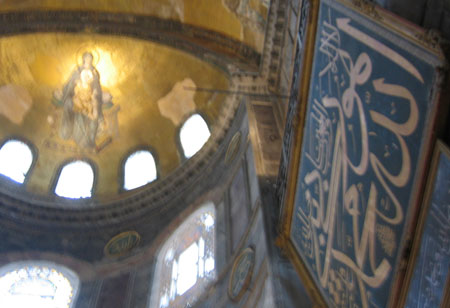
Christian figures and Islamic calligraphy in Hagia Sophia.
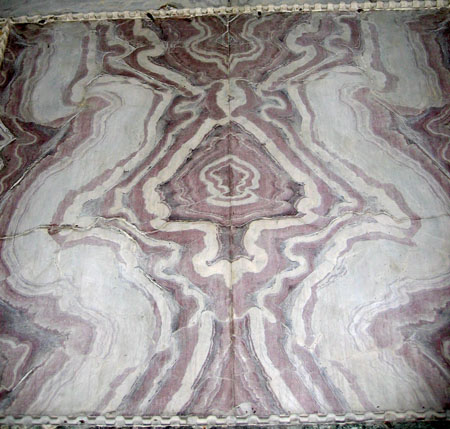
Mirrored marble in Hagia Sophia.
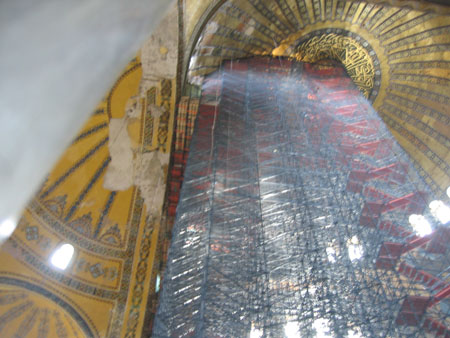
Beneath Hagia Sofia's dome.
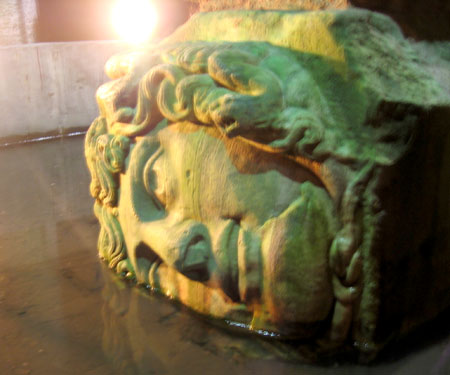
Gretchen's favorite Medusa in the cistern.
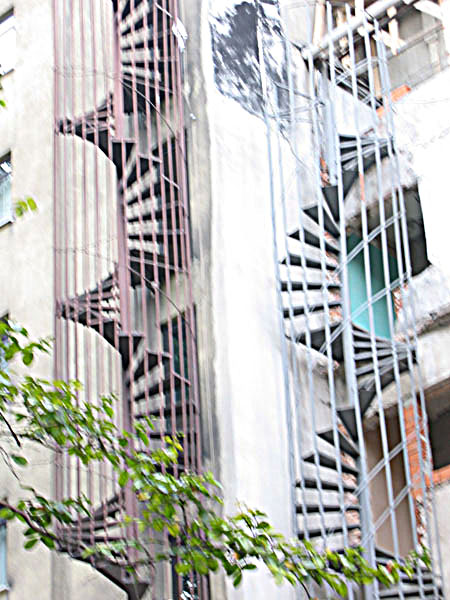
Staircases.
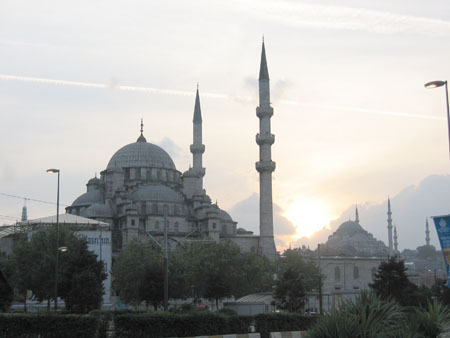
The New Mosque, foreground, (and others) at sundown near the Galata Bridge. The New Mosque was built about 400 years ago.
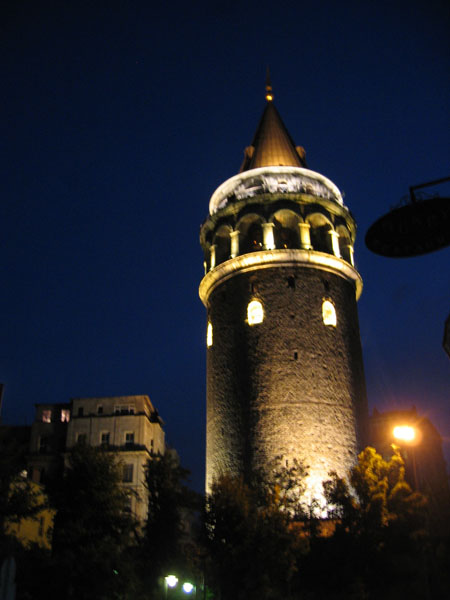
The Galata Tower.
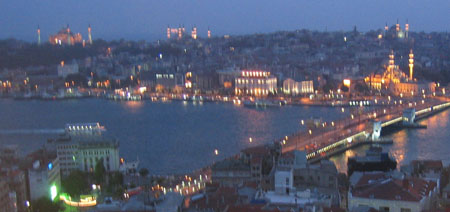
Old City skyline viewed from the Galata Tower, with Hagia Sophia (left background), the Blue Mosque (middle background), and the Galata Bridge (foreground). Nearest the bridge is the New Mosque.
For linking purposes this article's URL is:
http://asecular.com/blog.php?051009 feedback
previous | next |


















